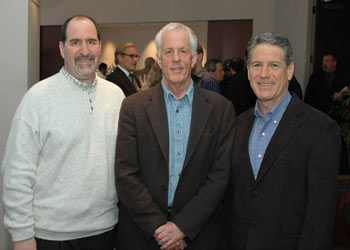70 Years of Milestones: 2000s
 Brain Trust: (left to right) Western AD/SM/PA Council Chair Scott L.
Brain Trust: (left to right) Western AD/SM/PA Council Chair Scott L. Rindenow, DGA President Michael Apted and Western AD/UPM/TC
Council Chair Cleve Landsberg. (Credit: Robert Hale)
The 1960 merger of the SDG and the RTDG gave the newly named Directors Guild of America both a major presence on the East Coast and significant jurisdiction in television, including the representation of the associate directors and stage managers who were part of television directors' teams.
The entry of these new members, combined with the merger of the IATSE Local that represented unit production managers in 1964, led to the formation of new member Councils to speak for these categories within the Guild. Although assistant directors working in feature film had been a part of the Guild since its inception, this influx of new below-the-line membership necessitated changing the former Council structure.
Four new Councils were created to meet the needs of members: the AD/UPM Council East and the AD/UPM/TC Council West (which also represents Technical Coordinators), and the AD/SM/PA Council West and AD/SM/PA Council East. Each of these four Councils has unique concerns, but all share the common goal of active representation of members in their job categories.
"The Councils on both coasts encourage members to bring issues to our attention so they can be addressed," according to Louis J. Guerra, chair of the AD/UPM Council East. Adds Dennis W. Mazzocco, chair of the AD/SM/PA Council East, "We have a regular, ongoing dialogue with members who are active in their field and are able to bring work experience, contacts and information that they gather on a day-to-day basis to the Council meetings."
 Eastern AD/UPM Council Chair Louis J. Guerra
Eastern AD/UPM Council Chair Louis J. Guerra

Eastern AD/SM/PA Council Chair Dennis W. Mazzocco
The primary mission of each Council is to serve as the venue for member participation in the workings of the Guild. The Councils are where members can hear on a regular basis about Guild policies, while leadership gets to hear about the concerns of members in these categories. Council leadership has the responsibility to keep members current on labor-contract issues, while encouraging them to share concerns about safety procedures, working conditions and employment.
All four Councils have numerous subcommittees and sponsor Guild events designed to hone their craft and careers. "Our members face many challenges to adapt to new technologies and evolving business models," says Cleve Landsberg, chair of the AD/UPM/TC Council West. "Each member must stay current with these changes, and the Councils and the DGA work to help our members achieve this."
Council members serve as mentors when possible, and occasionally take new members to work so they can experience different types of jobs. Since the Councils are constantly striving to stay up to date, members are encouraged to attend meetings to keep informed. "Our purpose is to generate interest in our current environment and in protecting our future through negotiations, training and education," adds Scott L. Rindenow, chair of the AD/SM/PA Council West.